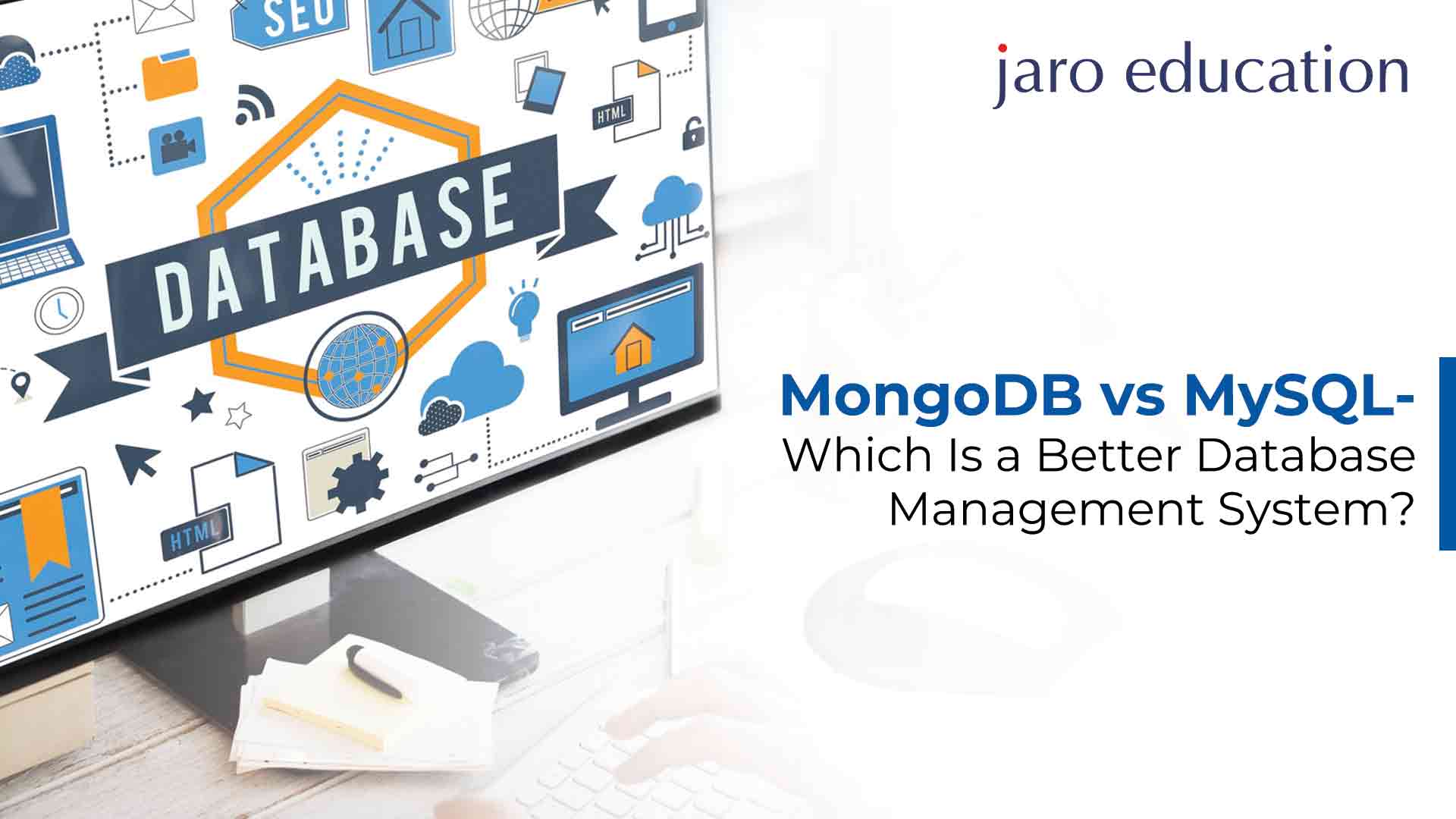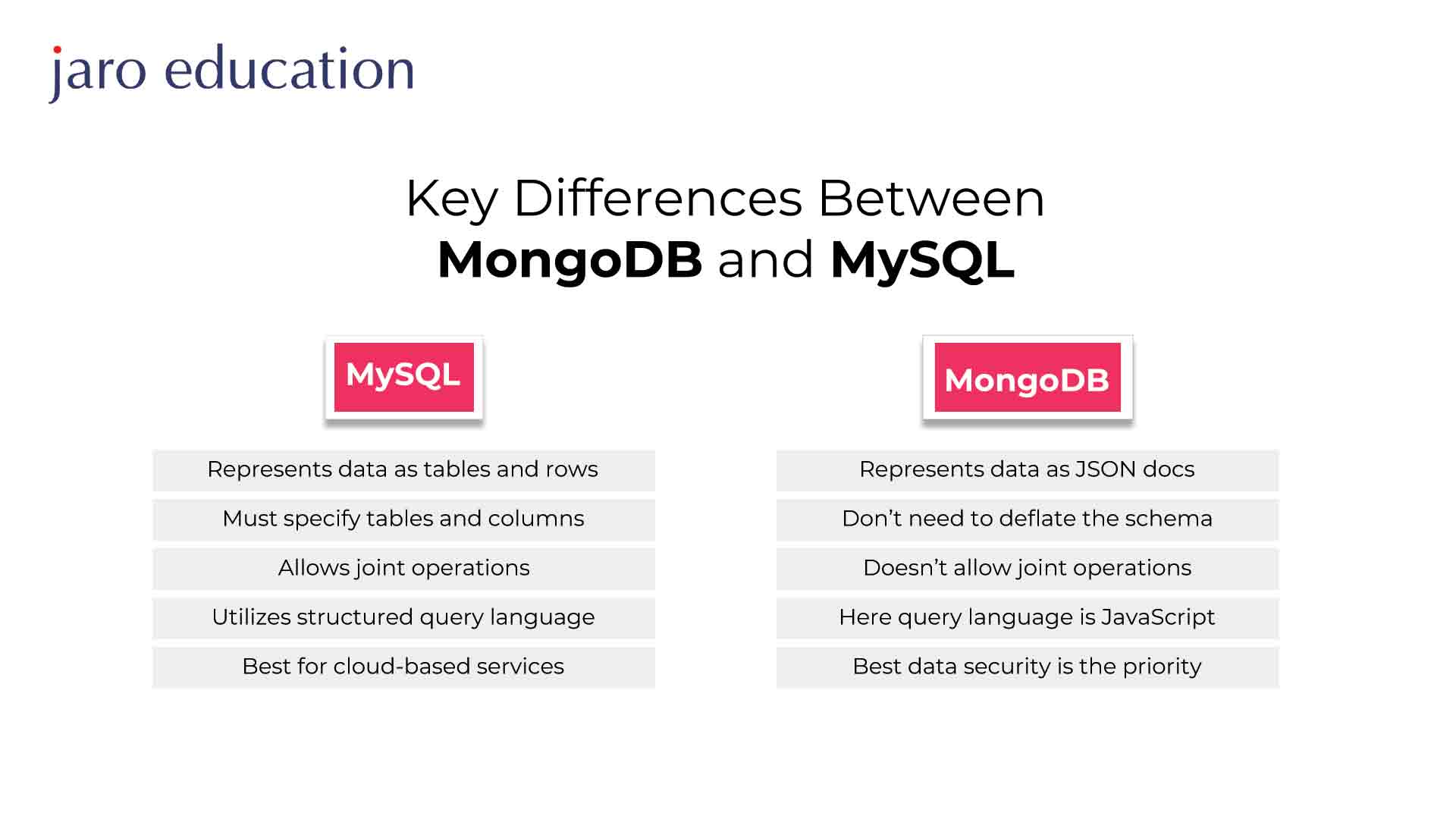MongoDB vs MySQL: Which Is a Better Database Management System?
Table of Contents

- jaro education
- 9, November 2023
- 5:00 pm
With the help of a database, anything is possible in modern times. Businesses that have to deal with huge volumes of data frequently use the popular management systems MongoDB and MySQL. Both the database management systems (DBMS) will let you gather information from a website or application and then produce reports but vary in terms of design. MongoDB is a document-based system, whereas MySQL is an antiquated table-structured system. Both databases have their advantages and disadvantages and are appropriate for a specific use case. In this blog, we will thoroughly comprehend the difference between MySQL and MongoDB, the two popular database management systems.
MySQL: A Relational Database Management System
MySQL, a widely adopted database system, is rooted in Structured Query Language (SQL) principles. It is a foundational model for developing Relational Database Management Systems (RDBMS). MySQL excels in data storage, query processing, and security across various applications, from large corporate databases to small, local business websites.
Key Features of MySQL
The features of MySQL are as follows:
Replication and Clustering
MySQL offers robust support for replication and clustering, employing various synchronisation methods. These features enhance program execution efficiency and provide fault tolerance, making MySQL suitable for high-performance applications.
Security
Prioritising data security by offering a range of protective measures is one of the vital features of MySQL. These measures include Secure Sockets Layer (SSL) encryption for secure data transmission, password protection, authentication plugins, and data masking to safeguard sensitive information.
Performance Schema
MySQL includes the Performance Schema, a feature that enables users to monitor and assess the server’s performance in real-time. This feature is valuable for optimising database performance and identifying bottlenecks.
Online Schema
MySQL provides online schema management tools that allow users to adapt to changing storage capacity requirements and enhance database functionality without significant downtime. This feature ensures continuous availability and flexibility for evolving data needs.
Backup
Various backup options are offered by MySQL to ensure data preservation and recovery. Users can perform full and incremental backups to safeguard their data. Additionally, MySQL supports logical and physical backup methods, catering to different data recovery scenarios and requirements.
MongoDB: A NoSQL Database Solution
MongoDB introduced an innovative method of database design. With “Mongo” meaning “humongous,” the term “MongoDB” emphasises the service’s ability to handle massive amounts of data. It became clear that flexible and high-performance database solutions were necessary as digital services and websites grew. As a distinguishing characteristic of the system, MongoDB stores data as MongoDB documents to meet this criterion.
Key Features of MongoDB
The key features of MongoDB are as follows:
Replication
MongoDB offers a robust replication feature that enables the creation of multiple data copies, which can be distributed across numerous servers. This ensures data redundancy.
Ad-hoc Queries
Supports ad-hoc queries, allowing users to perform various queries, including range queries, regular expressions (Regex), and field searches is an integral feature of MongoDB. Moreover, these queries can return specific text fields and incorporate user-defined JavaScript functions for added flexibility.
Sharding
For handling large datasets, MongoDB employs Sharding, which involves dividing extensive data into smaller subsets distributed across multiple MongoDB instances. This enhances performance and data management.
Load Balancing
MongoDB efficiently manages concurrent client requests by supporting load balancing. This ensures that multiple client requests can be distributed across several servers simultaneously, optimising system performance.
Capped Collections
It provides limited collections that automatically manage data insertion orders. This feature is handy for applications where data retention and order of entry are critical.
Horizontal Scaling
MongoDB’s architecture allows for easy expansion of database capacity. By adding more servers, you can achieve horizontal scaling, which is essential for accommodating growing data demands and maintaining system performance.
Difference between MongoDB and MySQL
The main differences between MongoDB and MySQL are as follows:
| Points of Difference | MySQL | MongoDB | Usage | MongoDB offers a user-friendly experience, particularly for those new to database management. Its schema-less design eliminates the need to define data structures in advance, allowing users with limited technical knowledge to start storing data immediately. The flexibility of MongoDB extends to its compatibility with various programming languages. This versatility empowers organisations to hire developers with diverse expertise.
MongoDB has also introduced MongoDB ATLAS, a cloud-based service, enabling users to easily manage, scale, and operate MongoDB in the cloud with just a few clicks. Its ATLAS facilitates data migration from popular cloud storage platforms like Amazon S3. MongoDB simplifies the process by eliminating the need to define schemas upfront, making it beginner-friendly. | It relies on SQL and is known for its ease of use. Even developers unfamiliar with MySQL can quickly grasp SQL, making it accessible. As a relational database, MySQL shines when developing applications that require high referential integrity and data security, such as financial or healthcare applications.
Setting up MySQL is straightforward; even those without prior knowledge can easily install and integrate it with platforms like WordPress. Various third-party tools simplify establishing connections to the MySQL database. Ease of use in MySQL depends on the developer's expertise. It benefits from a large community and years of market presence, making it a familiar choice. |
|---|---|---|
| Scalability | MongoDB distinguishes itself through its scalability features. It supports horizontal scaling, allowing the addition of nodes to increase capacity and handle higher workloads. Adding a server can readily accommodate the increased demand if your application outgrows the database's capacity.
Scalability
MongoDB distinguishes itself through its scalability features. It supports horizontal scaling, allowing the addition of nodes to increase capacity and handle higher workloads. Adding a server can readily accommodate the increased demand if your application outgrows the database's capacity. MongoDB offers two scaling methods: Replication and Sharding. Replication enhances fault tolerance by creating database copies that distribute read requests across multiple nodes. In contrast, Sharding distributes data subsets across nodes based on a Sharding Key, which effectively increases each node's capacity. | Scalability options in MySQL are limited. You can choose between vertical scalability or read replicas. Vertical scalability requires upgrading the system's processing power, memory, storage, and network speed. Adding servers to improve performance, as with horizontal scaling, is not an option in MySQL.
Read replicas reduce the load on a single server by creating read-only copies of data on different servers. However, there are limitations on the number of copies and challenges with write-heavy applications. While MySQL supports Sharding, it has various limitations and is less commonly used. |
| Sense of Security | It prioritises security with features like role-based access control, allowing user roles and privileges to be defined. TLS/SSL encryption secures all data traffic. Client-side field-level encryption enables applications to encrypt data fields before transmission, ensuring only authorised users with the correct encryption keys can access and decrypt the data. | It provides robust data protection through Access Control Lists (ACLs) that restrict unauthorised connections, queries, and operations. It also supports encrypted data transfer through TLS, enhancing data security when transmitted over public networks. Also, MySQL Enterprise Edition offers data masking and de-identification capabilities for concealing sensitive information. |
| Speed | MongoDB excels in storing unstructured data quickly, as there is no need to define schemas in advance. The data read and write processes are faster due to storing all information related to each entity in a single document. Features like replication and sharding further boost performance. | MySQL is relatively slower because it organises data logically in tables. It reads and write data from multiple tables which increases server load and slow down the process of data retrieval and updates. |
The above table provides a precise overview of the key differences between MongoDB and MySQL in terms of ease of use, scalability, security, and speed. Your choice between the two databases should be based on your specific business requirements and the nature of your application. To dive deeper into these aspects, let’s move further.
When to Use MongoDB?
MongoDB is the preferred database choice in several scenarios, including:
Data Integration
When you need to integrate data from various sources with different formats into a centralised repository, MongoDB excels. Its schema-less design allows for flexible data storage and retrieval, accommodating diverse data formats.
High-Performance Applications
MongoDB is well-suited for the back-end of high-performance applications that demand scalability and handle substantial traffic. Industries like e-commerce, social media, and IoT applications benefit from MongoDB’s horizontal scalability, enabling cost-effective expansion of database capacity as traffic grows.
Complex Data Structures
MongoDB is an excellent choice when dealing with complex and continuously evolving data structures. Its schema-less architecture allows you to adapt to changing data requirements without updating a fixed schema.
When to Use MySQL?
MySQL is a suitable database for specific use cases, including:
Data Security and Referential Integrity
MySQL is ideal when data security and referential integrity are paramount. It provides robust security features and enforces data consistency, making it a preferred choice for applications with sensitive data, such as financial, banking, or medical applications.
Fixed Schema
Situations where maintaining a fixed schema with structured, organised data is essential and in applications where data format and relationships remain stable over time, MySQL’s relational model is advantageous.
Novice Developers
MySQL is a favourable option for novice developers due to its extensive community support and low setup costs. The abundance of resources, tutorials, and documentation makes it accessible for those new to database management.
Low-Traffic Startups
For startups with low-volume traffic, using MySQL is a good choice, as it provides a reliable, cost-effective solution for handling smaller workloads that can scale as the startup grows.
Demystifying MongoDB Vs MySQL
The choice between MySQL and MongoDB depends on the specific requirements of your application:

MySQL for Structured Data
If your application deals with structured data and necessitates a traditional relational database, MySQL is an excellent choice, as it provides the structure and stability needed for applications like accounting systems that involve multi-row transactions, where data organisation and integrity are crucial.
MongoDB for Dynamic and Scalable Data
MongoDB is well-suited for applications requiring real-time analytics, content management, Internet of Things (IoT), mobile apps, and other scenarios characterised by rapid data growth. It’s the ideal choice when dealing with structured and unstructured data, especially if your data requirements are dynamic and evolving.
Conclusion
The decision boils down to your specific data needs and the nature of your application. In case of structured data and established relational database requirements, MySQL is the go-to option. On the other hand, MongoDB shines when you anticipate data growth, flexibility, and adaptability for dynamic data structures.
To get more insights on MongoDB vs MySQL performance, apply for Amity University’s Master of Science (Information Technology) program through Jaro Education. This program is a wise choice because of its extensive curriculum, which includes developing web-based technology, database administration, project handling, cybersecurity, programming, and other associated concepts.







